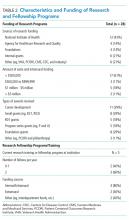State of Research in Adult Hospital Medicine: Results of a National Survey
BACKGROUND: Little is known about the state of research in academic hospital medicine (HM) despite the substantial growth of this specialty.
METHODS: We used the Society of Hospital Medicine (SHM) membership database to identify research programs and their leadership. In addition, the members of the SHM Research Committee identified individuals who lead research programs in HM. A convenience sample of programs and individuals was thus created. A survey instrument containing questions regarding institutional information, research activities, training opportunities, and funding sources was pilot tested and refined for electronic dissemination. Data were summarized using descriptive statistics.
RESULTS: A total of 100 eligible programs and corresponding individuals were identified. Among these programs, 28 completed the survey in its entirety (response rate 28%). Among the 1,586 faculty members represented in the 28 programs, 192 (12%) were identified as engaging in or having obtained extramural funding for research, and 656 (41%) were identified as engaging in quality improvement efforts. Most programs (61%) indicated that they received $500,000 or less in research funding, whereas 29% indicated that they received >$1 million in funding. Major sources of grant support included the Agency for Healthcare Research and Quality, National Institutes of Health, and the Veterans Health Administration. Only five programs indicated that they currently have a research fellowship program in HM. These programs cited lack of funding as a major barrier to establishing fellowships. Almost half of respondents (48%) indicated that their faculty published between 11-50 peer-reviewed manuscripts each year.
CONCLUSION: This survey provides the first national summary of research activities in HM. Future waves of the survey can help determine whether the research footprint of the field is growing.
© 2019 Society of Hospital Medicine
Research Fellowship Programs/Training Programs
Only five of the 28 surveyed programs indicated that they currently had a research training or fellowship program for developing hospitalist investigators. The age of these programs varied from <1 year to 10 years. Three of the five programs stated that they had two fellows per year, and two stated they had spots for one trainee annually. All respondents indicated that fellows received training on study design, research methods, quantitative (eg, large database and secondary analyses) and qualitative data analysis. In addition, two programs included training in systematic review and meta-analyses, and three included focused courses on healthcare policy. Four of the five programs included training in QI tools, such as LEAN and Six Sigma. Funding for four of the five fellowship programs came from internal sources (eg, department and CTSA). However, two programs added they received some support from extramural funding and philanthropy. Following training, respondents from programs indicated that the majority of their graduates (60%) went on to hybrid research/QI roles (50/50 research/clinical effort), whereas 40% obtained dedicated research investigator (80/20) positions (Table 2).
The 23 institutions without research training programs cited that the most important barrier for establishing such programs was lack of funding (12 programs) and the lack of a pipeline of hospitalists seeking such training (six programs). However, 15 programs indicated that opportunities for hospitalists to gain research training in the form of courses were available internally (eg, courses in the department or medical school) or externally (eg, School of Public Health). Seven programs indicated that they were planning to start a HM research fellowship within the next five years.
Research Faculty
Among the 28 respondents, 15 stated that they have faculty members who conduct research as their main professional activity (ie, >50% effort). The number of faculty members in each program in such roles varied from one to 10. Respondents indicated that faculty members in this category were most often midcareer assistant or associate professors with few full professors. All programs indicated that scholarship in the form of peer-reviewed publications was required for the promotion of faculty. Faculty members who performed research as their main activity had all received formal fellowship training and consequently had dual degrees (MD with MPH or MD, with MSc being the two most common combinations). With respect to clinical activities, most respondents indicated that research faculty spent 10% to 49% of their effort on clinical work. However, five respondents indicated that research faculty had <10% effort on clinical duties (Table 3).
Eleven respondents (39%) identified the main focus of faculty as health service research, where four (14%) identified their main focus as clinical trials. Regardless of funding status, all respondents stated that their faculty were interested in studying quality and process improvement efforts (eg, transitions or readmissions, n = 19), patient safety initiatives (eg, hospital-acquired complications, n = 17), and disease-specific areas (eg, thrombosis, n = 15).
In terms of research output, 12 respondents stated that their research/QI faculty collectively published 11-50 peer-reviewed papers during the academic year, and 10 programs indicated that their faculty published 0-10 papers per year. Only three programs reported that their faculty collectively published 50-99 peer-reviewed papers per year. With respect to abstract presentations at national conferences, 13 programs indicated that they presented 0-10 abstracts, and 12 indicated that they presented 11-50.








